Thermal Mass Rocket Stoves on our Minds…
- Bill Wilson
Why Thermal Mass Rocket Stoves are part of This Permaculture Design
Whereas wood gasification turns wood scrap into a flammable gas to run engines (generating electricity power and heat), a thermal mass rocket stove simply turns scrap wood into heat…. lots of heat…with a lot less wood!!! So, we have included them in our overall design, especially for Earthcamp Village, because they are:
Bottomline: They burn 1/4 of the wood to generate the same heat from a conventional wood stove and the outgases are 90% cleaner as well. The Key? They burn the wood, smoke and gasses at very high temperatures…SAFELY! |
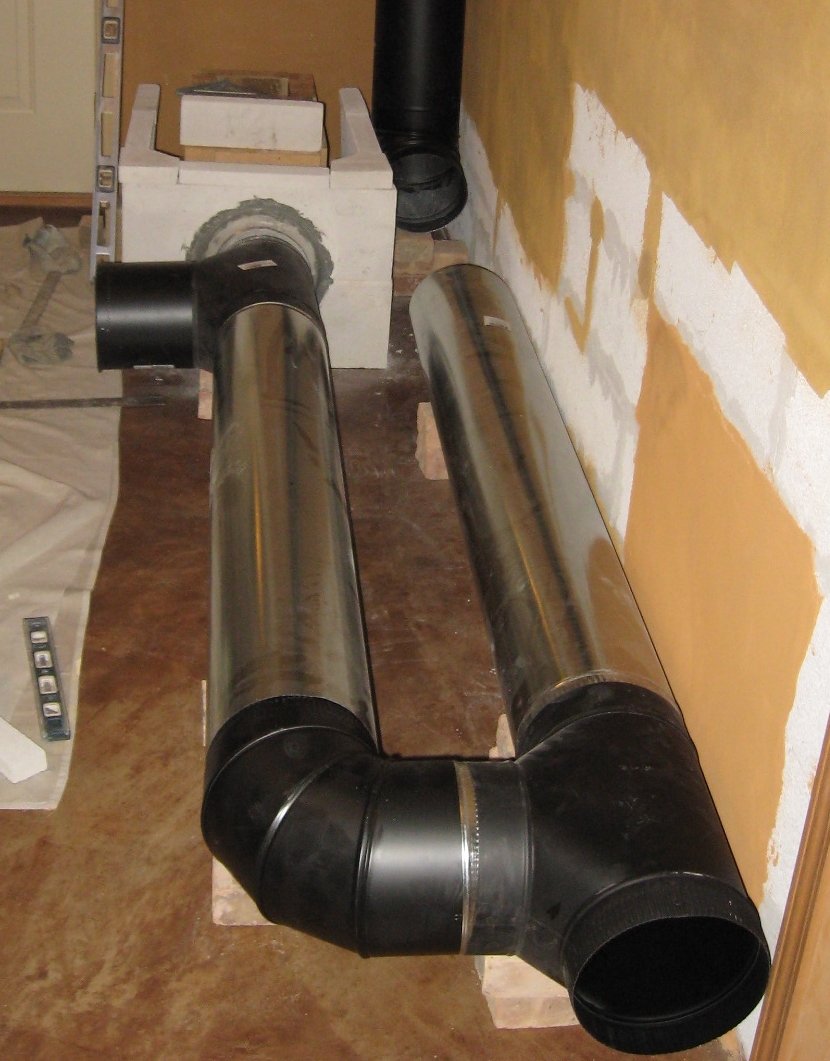
Thermal Mass Rocket Stoves Explained
Not long ago, our friends and neighbors, Bev and Wayne, started to build a thermal mass rocket stove in their living room. Wayne took one of our PDC courses and was inspired by the rocket stove concept (See the illustration and links below).
Bev and Wayne have been sharing their adventure with us and we are very excited about the possibilities.
Imagine having a wood burning stove in your home that:
- Burns less than 1/4 the amount of wood you typically burn
- Keeps you as warm or warmer
- Allows you to easily burn sticks, twigs and branches instead of just large chunks of firewood.
- Burns cleaner than any wood stove ever made
The big thing for us, living here on the prairie in Illinois surrounded not by woods or forests but by corn and bean fields, is the very real shortage of easily available firewood.
What I am talking about are the large hardwood trees with trunks and large branches which are typically chainsawed to length and then split to fit into a wood burning stove. All of this tonage of wood then needs to be hauled out of the woods, dumped or stacked somewhere, then loaded back into a truck for delivery to be driven to someone’s home (a lot more energy) and then unloaded and stacked again for winter use.
Up-to-date Picture of Above Stove at Bottom of this Post
|
About the Thermal Mass Rocket Stove… When fired up properly, the stove can make a quiet sound, similar to that of a “rocket” as the high temperatures uniquely created within the stove pull in more and more air and burn off the hot gasses from the burning wood. Click on the photo below to read a great article about these stoves. 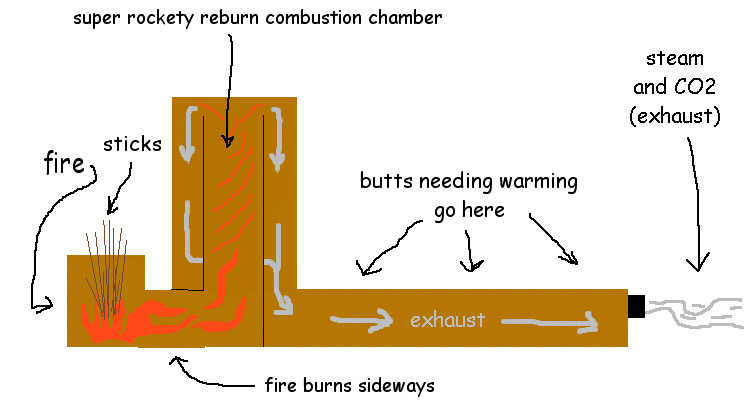
|
|
This book explains in detail exactly how to build one, then how to use it in a range of applications. They discuss materials: where to find them, what to pay and how to make use of found and recycled parts. The section on fire and fuels is thorough but simple. |
|
With the use of traditional firewood, we are talking about the consumption of a lot of fossil fuel (gasoline and oil) as well as the need for a good amount of human labor (time). |
So, imagine for all of us prairie or rangeland dwellers that there would be an option to be able to grow and harvest the wood we need to keep warm in the winter within 2-3 years, instead of waiting 10-20 years for a tree to grow large enough to harvest. These thermal mass rocket stoves can easily burn 1-2 inch diameter branches which can be grown in a short time and harvested with just loppers or pruning shears.
|
|
|
This is big…big…big…news…!!!
When the price of fossil fuels and electricity begin to soar, so will the price of firewood. With an increase in the demand for firewood comes the risk of harvesting too many of our trees and the potential to further disrupt the ecological balance on our planet. Besides, a full size tree takes a couple of decades to grow. Will we really have time to wait?
| With the use of a thermal mass rocket stove, our annual supply of firewood could be harvested with a pair of loppers, pruning shears and a garden cart. |
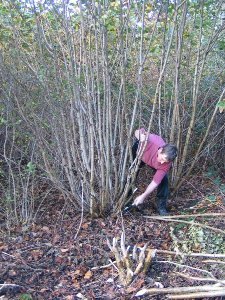 Photo: Bill Hogarth, an English expert Coppicing Hazelnut
Photo: Bill Hogarth, an English expert Coppicing Hazelnut
Quite literally, farmers will be able to convert some of their prime (and not so prime) farmland into the raising of selected firewood brush using the long honored art of coppicing. For example, a farmer could grow hazelnut bushes for the nuts. Once every 7-10 years, it’s a good practice to coppice the hazel bush (cutting it completely off, close to the ground) thus harvesting the perfect firewood for a rocket stove. The next season the hazel bush springs back to life and will begin producing nuts again in another 2-3 years.
This is why permaculturalists have such a passion for food forests. In a food forest we not only grow the foods we need to eat, we can also produce fuel and fiber while simultaneously building topsoil. Food forests improve the land and water with every successive generation of farmers. Traditional row-crop farming however does just the opposite. We loose massive amounts of topsoil every year worldwide and especially on industrial farmed soils.
So, the implications of the widespread use of this stove and a new firewood harvesting system are substantial:
- Decreasing our need and use of polluting fossil fuels
- Harvesting the energy from current sunlight instead
- Repairing damaged farmland
- Providing income and right livelihood for farmers and growers
- Harvesting CO2 out of the atmosphere and storing it into wood and soil
- Minimizing flooding (woodlands hold much, much more rainwater than farmland)
- Creating habitat for wildlife
- Providing greater homeland security
Cheers…. Bill Wilson
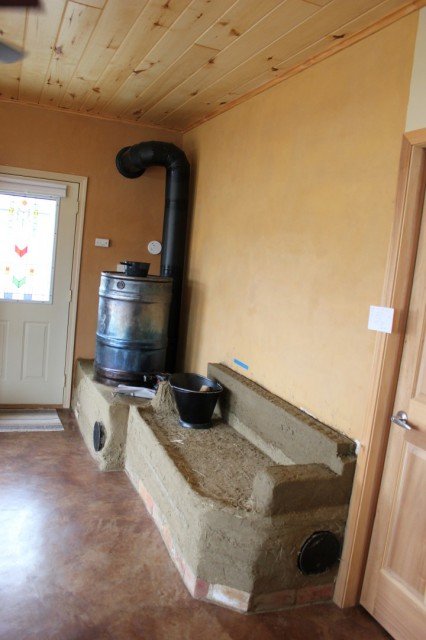
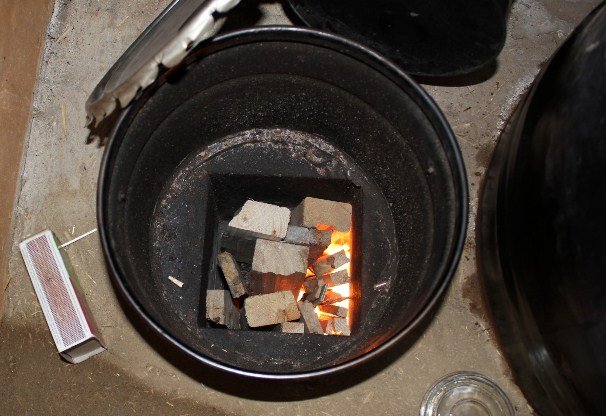
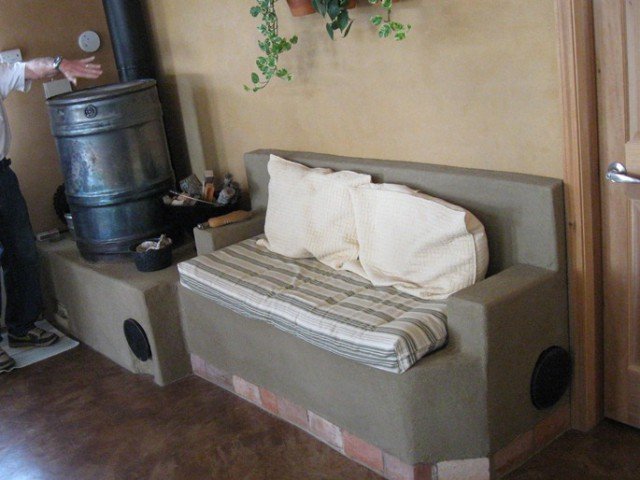
Here is a Link to a fun article from ‘Morning Chores’ with:
21 Free DIY Rocket Stove Plans for Cooking Efficiently with Wood
[contentblock id=10 img=gcb.png]

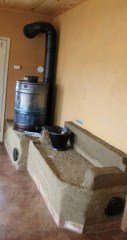
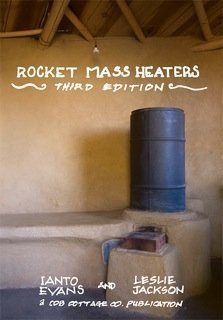


62 thoughts on “Thermal Mass Rocket Stoves on our Minds…”
Do u have a rocket stove workshop?
Nothing scheduled at this time Rita nor in the planning for 2023. Best bet is to keep an eye on our monthly emails to catch the next rocket stove workshop. Thanks for asking.
Milton, We want to add a Rocket stove for heating in our basement where there is a fireplace already. We learned in the last 4 day power outage that keeping both the upstairs and downstairs fireplaces going 24/7 the house got down to 38 degrees, it was very cold. Have there been improvements that work in changing fireplaces to Rockets yet?
could a bake stove be added to the rmh, simalar to a russian stove
Absolutely.
I need some help!! I am building a Timber Frame home with a walk out basement. I want to put a Thermal Rocket mass heater in the basement along the outside wall, with a large seating area. The room is 12’ wide x 22’ long x 10’ high ceilings. My builder is concerned that the Rocket heater give off way to much heat and make the space far too hot.
How do we determine the proper size heater for a space? Please help. I do not want to install a traditional Wood stove.
Kevin in Swain NY
In order to function properly the rocket mass heater(RMH) will have to exchange a lot of heat through the barrel while you are charging the mass. Once the mass has absorbed sufficient heat you’d just coast on that. It will really heat up the space while you are charging it but be very comfortable afterwards.
The two things I would be concerned with are having the RMH in that space in the basement and the length that you push the exhaust through, both of which may cause drafting problems in the stove. I would do a lot of experimentation and get very comfortable building and taking down a stove and build many test models outside the home. A badly placed/designed/functioning RMH will be much worse than a wood stove, I would seriously consider that as an option.
We are planning to build a rocket mass stove and would like to be able to cook/bake and heat water with it. we are also planning to make logs from paper sludge. Any ideas or plans for one that is working?
Just be aware that sometimes the more things you try to get the rocket to do the worse it will be at all of them. It’s pretty easy to heat water or cook on the typical rocket mass heater, the top of the barrel is a reasonable heating surface. Do be aware that it’s only going to be hot a few times each day. In order to cook you might need to run the stove extra, essentially overheating the room. I have seen oven designs built into rocket stoves, never tried one so I can’t say how well they work.
Don’t see why the paper sludge logs wouldn’t work, you’d just have to make them smaller for a typical J tube, or you could look into a batch burner. It’s a bit experimental still but I guess so is a rocket stove mass heater!
Can you burn bio bricks in a rocket stove? If they were made into a thinner brick? I understand the need for an insulated flue for complete combustion, would using refractory fire brick for the burn chamber and flue serve the same purpose? Thanks!
I’m sure bio bricks would burn but the devil is in the details. Since I have no experience with bio bricks you might have to burn them with plenty of other materials, only by themselves on a bed of coals, split them down, or some other way to make them work reasonably. Rocket stoves do best with small diameter wood, the larger surface area and space for air to get in are what make that fuel the best.
You should use refractory fire brick in the burn chamber and additional insulation both. The stove might work reasonably well with other configurations but those two together make for the longest lasting, best burning stove.
We’d love to hear any results if you decide to try these configurations out! Rocket stoves are experimental enough that there are no definite answers, just many questions…
Hello,
We did live in Rockford IL.for 35 years,now live in the North Georgia in the mountains way out in the country in a cabin with a big rock fire place inside rock goes up 38 to 40 feet inside to the roof.I want to put in a Rocket Mass heater however trying to see how I can get rid of my fire insert and install a Rocket Mass heater….
Depending on local regulations/building code and your home insurance it might be best to stick with the insert. Theoretically it would be possible to build a RMH insert but that may not be the highest leverage point for such a heater. Might be better to find an outbuilding or other location to build one. You could build your knowledge without battling large institutions that are pretty much guaranteed to win if you’re “found out”…
How many cubic feet of air per hour does the average rocket stove remove from your house? Can you use outside air?
I’m not sure of an exact amount but it certainly could be a significant amount. If your house is too tightly sealed you can have draw problems for just that reason.
Remember you would only have draw while you were charging the mass, just like any other stove the flue should be closed when not in use.
Configuring the stove to draw outside air would be fine as long as you do not restrict the draw. The stove will work better too if the air is preheated.
Overall I’ve not heard anything specific complaints about pulling cold air into a house. Things work a little differently when you’re heating a mass and not the air…
Hi there,
I have built a dry run of my thermal mass rocket heater.
It is working fine until the ash can fill up. This takes about an hour and when it begins to fill up I start getting blow back. Or at least fire coming up the fuel and rising up the feed chamber. The ash can I have made is just the same size as the feed chamber at 5″ x 5″.
I have the feed chamber at 10″ high above the ash can, the burn tunnel at 5″ x 4.5″ then the riser is 20″ high with a 6″ centre. Insulated inside an 11″ diameter can with vermiculite. The oil barrel I have over it is 23″ diameter and sits 2″ higher than the riser. The whole thing then goes into a 6″ exhaust.
Please can you advise me what I am getting wrong.
I would very much appreciate any information any one can offer.
Kind regards,
Frank.
Hi Frank,
It sounds like things work well until the coals build up. I’ve found that a big pile of coals effectively reduces the air intake and chokes the stove off, that sounds like what is happening to you. You might need to have more of an ash pit or burn it differently: burn it as hot as you can, when it starts to flame back up the feed tube don’t add any more wood until you let it burn down a bit or clean out the coals.
These stoves seem to be as much about technique as innovative design.
And Frank… How tall is your exhaust pipe? Our friends here is Stelle were getting blow back and their exhaust was vented outside through the wall at about 8 feet. I suggested he put an elbow on it and extend the exhaust pipe 1-2 feet above the roof ridge. That made a huge difference. It creates a very strong draft now that he actually dampers down to control the burn. Nice problem to have and no blow back. Sorry I didn’t see your comment earlier.
This sounds great, however, it seems that home insurance would not even consider allowing this product in the home. It would have to pass may tests to even be considered. Although it sounds wonderful, I fear it to be deadly. I foresee many homes burning to the ground due to uneducated people using untested, unapproved devices.
It is my understanding that a wood burning appliance would need to be UL approved or be built by a licensed mason in order to sufficiently navigate insurance and most building code requirements. Building within established guidelines is a great way to ensure that these efficient devices are safe. For any DIY applications I would recommend building the stoves outside in a sheltered space.
You have a right to be afraid of the consequences of fire but in my experience with these stoves I would be more concerned about exhaust gasses than the flames themselves. Appropriately placed smoke and CO detectors should be an essential part of any home in addition to following building standards for wood burning stoves and chimneys.
Overall I think the user of a rocket stove would pay more attention to the device that heats their home than the average person would to their furnace and therefore be safer in the long run.
Something else to look at in the draw issue is the exit from the barrel. I have an elbow coming out of the side of the barrel near the bottom. I have seen suggestions that would have the bottom third of the barrel dump into a funnel made of cob that enters the exhaust system. That makes sense in that the elbow exit above the bottom rim of the barrel is bound to create some turbulence. I found that idea on permies.com. http://www.permies.com/t/13531/stoves/Poor-draw-floor-system#122976
Do you have Bill Wilson’s dimensions for the feed tube, burn tunnel and heat riser? We have Ianto’s book and we’ve been building test rocket stoves with loose fire bricks. We’re now on version 7 and getting quite desperate as we can’t seem to find the perfect design. We keep getting too much smoke back when we light the fire and while it draws OK we don’t quite get that super rockety burn that it’s supposed to have. We need to start building and don’t know what else to change.
I don’t have the specific dimensions but have found that testing with loose firebricks can leave little air gaps that hinder the performance of the stove. I would recommend using a little bit of clay between the bricks, more to seal the gaps then to hold it together. We’ve also seen that having a 6′ rise at the end of the exhaust run can make a difference in the overall performance of the stove.
Bill here Annelie… I like Milton’s comments. Bottomline from my modest experience… put in a very tall chimney at the end…. Two feet above your roof line…minimum. If you are just experimenting with loose bricks… get the stack up about 8-10 feet and see how it pulls. Let us know what happens. Good luck.
I am in the second year of living with a rocket stove. I have never been able to get the down draft system to work well. There is always some smoke back. The solution was to create a horizontal burn box. This works well and I would like to experiment with modifying more conventional stoves. I needed a fan at first to get enough draw. I finally added an insulated stack outside that rises above the roof line. This was the answer. The stove is working beautifully now.
Yo Rick….
That was the exact same experience that Bev and Wayne had….worked great 80% of the time and then smoke would back up into the house. Knowing of the great draw that a stack has if it is run above the roof line for a wood burning stove, Wayne did the same and BINGO… draws like a charm and no smoke in the house. He has actually had to create a bit of a damper to slow the draw or air-intake down. Sweet.
When and where are your 2013 workshop schedules? I am interested in attending one for rocket stove mass heaters and soves.
We’re working on it. Specifically I’m working on a one day rocket stove workshop, we’ll see how soon I can get nailed down and posted.
Hello,
I am very interested in the 8″ system. I would like to put 2 in my house. I have a walkout basement home 4200sf. I am not looking to compeltely cover the expense of our heating bills but am looking to take a bit of the edge off. I live in Buffalo, MN where the winters can get a bit harsh/expensive. We recently looked into getting a geothermal unit installed but find it to be still expensive even after the tax break. My sister turned me onto permies.com and this has been so useful! Wood is not an issue here but using less is always a strategy of mine. How many st will an 8″ diameter system heat and how many cords with an average 15 degrees during the winter months (heat for 6 months at this temp)That’s just an average and simple for me to consider the entire year. Also, can I box in the unti with doors to access the cob unit? I want it to be wainscoated in under windows. Thanks so much! Meg
Hi Meg,
Rocket stoves are still a bit experimental as far as all that goes. It’s generally stated that they use 1/8th the wood of a conventional stove. You could design it any way you want, that certainly includes the possibility of doors. If you’re still interested I would recommend building many tests and taking a tour to see existing ones.
Anyone have a link to an earth bag home that is insulated on the outside with straw bales? Thinking of earth bag walls, insulated concrete floor, rocket stove mass heater for a huge thermal mass.
Never seen or heard of an earth bag home needing straw bale to insulate. The earth bag home stand alone is solid and will not need additional insulation. Earthbagbuilding.com is a great resource. Additionally, have you thought of an earthen floor sealed with linseed oil? We are planning to build an earth bag home in Wisconsin in two years and we are also including a rocket stove as one source of heat…good luck.
Hi Joseph, I recommend staying in an earthbag home in very cold weather. The heat moves into the walls and then right outside, it’s very hard to stay warm. Insulation on the outside keeps the heat in the walls and reflects it back into the space. In a cold climate I think insulation is a good idea. Straw bale is just one way to do it, there are many others. Either way the building is very solid.
A really fine bush/tree to copses for small to medium diameter wood is the filbert or hazelnut. They grow rapidly. The more you cut the more they sprout, and it only takes a couple of years to bear 2-3 in diameter wood. A quarter acre of these would supply your needs forever.
We were thinking right along the same lines Roy. And beside all of the biomass, we could harvest a ton of nuts.
And the nut shells burn really hot as well…!!!
has anyone built a rocket stove in minnesota, we are thinking of trying to build one but would love to see one in person and talk to someone who has built one in minnesota. how does it hold up to the humidity in the summer, also what can you all use to build the mass of the stove
I don’t know of any specifically in MN. The humidity of IL is no problem for the ones I’ve seen. The mass is usually cob, a mixture of straw, clay, and sand but can be augmented with stone. If you’re interested in building a rocket stove I recommend several things: a book, some videos, seeing some examples, and some experimenting before you do anything permanently.
Has anyone done any work on converting an existing fireplace into a rocket or masonry stove? We’re in the process of buying a different house that has an existing fireplace. We’ll have to do something with it to increase the efficiency. Would love to use the rocket concepts or even masonry stove concepts. Anyone have thoughts or experience to share?
Hey Guy… Hope someone responds who actually has some experience. but if not, what I can tell you is that your existing fireplace can act as the final outlet for a home built thermal mass rocket stove. The entire stove is built off to the side and the final journey of the flu ends up being spliced into your chimney.
Good Luck… Bill
Thanks Bill. I did find another blog/site where someone had done just as you said in more of a “portable” way vs. permanent. Looking forward to the adventure!
Hey guy do you have the blog info that you found ….would love to check it out
I have been dreaming and schemeing on the rocket stove design for my place since the fall. I am just about ready to jump into it! Anybody close to Fayetteville, AR with some experience in building one?
I would love to see more pics of Bev & Waynes set up. It looks like they have installed in a more “convential” house with drywall on the walls. I was wondering how they protected the walls and how that has worked for them?
@Charity, Make sure to build test stoves outside before you bring anything inside. Sometimes, you just have to step up and be the expert… Also I recommend the book above, it answers many, many questions. We’ll try to get some pictures of Bev & Wayne’s stove in the future. I know he posted some already in forums; you might be able to search for them…
Thanks Milton. Yes, steppin’ up seems to be my destiny! 🙂
I will let you know how it goes. Also thanks for the picture tip.
@Charity, There are some posts of Wayne’s rocket stove in the blog post for our Winter 2012 PDC
I really, really, really want me one of those.
Rob Frost is growing willow to coppice on his Energy Farm. That could probably work for Trish.
Judy, you can start to play with the basics just by building one out of a few bricks. We’ve got pictures from three of our courses.
Willow is indeed supposed to make a good fuel for a rocket stove…
I am wondering about cleaning away build up of creosote. I understand it burns HOT, but there must be some build up, no? With all those twists and turns, and the fact that there appears to be no option for cleaning the pipes in the cob bench, could this pose a fire hazard?
If it’s in good working order it burns at a very high temperature. I have not seen any build up in my experience, but that doesn’t mean it’s not there. The best stoves are designed with clean-out points, you can see two of them in the first picture above. Worst case none of the materials are truly permanent, you can always take the stove apart, clean and make any necessary repairs, then put it back together. This is good too in case you mess something up in the initial construction…
Hi Milton,
Do you remember Vic and Vicki from a couple summers ago?
I don’t see a price anywhere. Do you build and ship to sell?
Hope things are good for you. Sure do enjoy eating our daylilies!
I remember you two! The materials can run you anywhere from free to $600 depending on how much you scavenge and recycle. This would be something you would have to build on site; We’d be happy to discuss what it would take to make it happen. Remember though, rocket stoves are highly variable, depending on what materials you make it from and experimental. They take a bit of testing and feeling your way through the construction process.
I’d start with the book, the picture in the green box above links to a place you can buy the book.
What I wonder is how much tending the stove needs. I feed my woodstove generally 4 times a day. Could this do with as little attention?
No ! this stove works best with small finely split wood, it will need hourly attention over a period of 4-6 hrs, which will then hold enuf heat to heat approximately 800 sq,ft., over the next 24 + hours ! larger systems need only a little more attention over the same time period, to maintain the same amount of thermal coverage, over progressively larger sq. footage, though it will work best with a 2 story layout and the Rocket Stove Mass Heater on the ground floor !
Check out Permies.com ,and the wood stoves forums ! Allen L.
You COULD put together a chute at an angle and load up that chute end to end with 3 to 4″ diameter “logs” i.e. small tree parts. Just make sure your burn chamber is built in such a way (at an angle as the chute is) so as to have the wood feed into it effortlessly. As the 1st log/branch is burned away the … ehem … “log jam” (sorry, I couldn’t resist) will begin to slowly slide down the chute, thus feeding itself into the fire. It could work!! Man! I should make a BUSINESS out of building these things for people!!
We LOVE this idea. However, we don’t have lumber readily available anywhere near us, living on the far north Great Plains in northwestern MN near Canadian border. We use wood pellets in the pellet stove right now but know it won’t be enough if we get a BAD winter. Would your stove work with pellets?
There’s no reason you couldn’t burn pellets but it’s not something I’ve tried directly. You’d probably have to do some experimentation to make sure it works the way you want.
The stove requires a lot of attention then none. You build a hot fire and capture the heat for later in the thermal mass.
Rob Frost is growing many, many willow plants at his Energy Farm, with an eye toward coppicing it in a couple years. I don’t know how he plans to use it, but it would probably work in one of these stoves.
http://onestrawrob.com/
You can see a rocket stove design that uses pellets here: http://youtu.be/7wqJQmD-eVo
I tried wood pellets in my stove and found them not very practical. They are hard to light without accelerant or a bed of hot coals underneath then when they get going they really need a lot of air, they tended to create a lot of smoke until they got going, so I couldn’t start with very much pellets. Once it gets going I could only add a couple of 8 oz cups at a time. They do burn hot and will really heat things up, but need almost constant feed. This is something that needes to be experimented with outdoors.
This is the goto site for RMH everything here is a post re: pellets http://donkey32.proboards.com/index.cgi?board=discuss&action=display&thread=676
HI, I don’t have a pellet stove, but an ordinary wood stove, due to frequent power outages….. though, I purchase wood blocks (bio bricks) made the same way as the pellets, only bigger. Our “local” factory which makes the pellets, I believe also makes the bricks, and many do come out of Canada. They come in a variety of sizes to us. They burn clean and hot and don’t need a lot of draft. about $8 for bundle. Depending on the size, about 10 – 20#. They make logs too. Some think it’s more expensive, it may be, but it works for me, it burns cleaner, right down to fine ash that is compostable. and it stacks real nice and easy in the corner!!!! When considering the amount of work and time which goes into wood, the price to me is worth every penny.